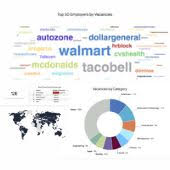
7 Questions to Ask Before Buying Job Board Software
Just starting your job board? Been in the game for a while and looking for a refresh? Somewhere in the middle? Wherever you are in your job board journey, we’re here to help you make an informed decision about the software you use to run your site and, most importantly, keep your clients (and job seekers) happy.
Read on to learn more about why these seven questions are so important and what you should prioritize when it comes time to find new job board software.
1. How easy is it to upload job listings?
Adding jobs content to your job board is a vital part of your work. Recruiters hate manually posting jobs, even if you offer them for free. Your job board software can determine the complexity of automating this task: the better the software, the easier it is to upload listings. And you definitely need to make it easy for recruiters to post jobs.
When seeking out job board software, look for integrations with organic backfilling sources or for vendors that offer their own job scraping services. This way, you can enhance your job board with targeted jobs content.
If you’re, say, running a job board for high school educators, you could use organic backfilling to populate your job board with teaching positions across the country. If you want to narrow your scope – add teaching jobs from certain districts, for instance – you can have your vendor scrape and extract listings from those specific schools.
2. How customizable is the software?
The right job board software will let you (often with help from the vendor) adjust the look and feel of your site. You might have a custom banner. You may have a logo for the homepage. Or maybe you have an existing brand with color schemes, typefaces, and a homepage design that you want reflected on your job board.
Whatever the design parameters, your job board software should accommodate them. (And if you don’t want to come up with designs on your own, your vendor should also have templated options for you to choose from.)
But that’s not where the customizability should end. The best job board software also lets you control functional aspects like…
- Defining which information employers must provide in listings (this is great if you want to, for instance, mandate salary transparency on your site).
- Defining visibility of job listings (useful for sponsored posts).
- Choosing resume field options for candidates who apply for jobs directly from your job board.
Want more customization? Look into a job board software provider that lets you purchase licenses to its code (*cough cough*). With a license, you get free reign to edit, own and control the code – whenever you want. That means you can build your own integrations, host your job board on your servers, and take full control.
3. Is the software mobile-friendly?
Mobile-friendly job board experiences are now a baseline expectation (67 percent of job applications were completed on mobile devices in 2021).
Your job board software must deliver that mobile-friendliness. What does that look like? Optimized designs for easy scrolling. Application features that let candidates upload Dropbox files of resumes from their smartphones. Readable fonts at any screen size.
A useful litmus test: can candidates use your job board to complete core actions (search, save, and apply for jobs) regardless of the device? If so, you’ve found your mobile-friendly software!
Remember, mobile-friendliness encourages a greater population of candidates to apply for jobs, which goes a long way toward helping your customers improve diversity, equity, and inclusion in the hiring process.
4. Will I have a dedicated customer support team?
You don’t want your customer support tickets piling up. If you’re committing to a job board software vendor, you want it to feel like they’ve also committed to you.
When evaluating vendors, ask if you’ll have a dedicated account manager. Inquire about average response times. Confirm they offer assistance beyond the implementation process. The software itself is important, don’t get us wrong. But you need the right support team to maximize its value. Some of the less expensive options offer little to no on-going support.
5. What features make it easy for candidates to search and apply for jobs?
The ultimate goal of a job board is to fill employers’ job openings with the most qualified candidates. Logically, a huge piece of that comes down to how easy it is for job seekers to find and apply for jobs on your site.
To achieve that, the best pieces of job board software…
- Offer various search features (boolean, keyword, location radius search, industry, etc.).
- Include other search tools like subscriptions to RSS feeds and email job alerts. (There should also be a section to save jobs).
- Let candidates apply for jobs directly from your job board – rather than redirecting to the employer’s ATS.
Mobile-friendliness ties in here, as well (and so do features that let candidates store resume files locally on your site for a simplified application process).
6. How can I manage payments from my customers (employers)?
So far, we’ve highlighted a fair bit about the candidate’s experience with your job board. But it’s also important to focus on the experience that employers have with your job board. One key part of that experience? The payment process.
Depending on the size of your job board and the industries you serve, there are likely two buckets your customers fall into:
- Large enterprises with dozens of job listings at any point in time.
- Smaller employers with infrequent hiring needs.
Customer one, in this case, may opt for a subscription model where they can pay a recurring fee and post an unlimited number of jobs to your site. Customer two may instead opt to pay per post.
Your job board software should accommodate both pricing options.
7. Will this software help my job board win in search?
One of the easiest ways to attract more applicants to your job board is to optimize your listings for Google for Jobs.
The two key steps to optimizing your listings:
- Use structured data when coding your job listings.
- Keep your listings up to date.
Your job board software can help you with both of these tasks. Ask potential vendors if they use structured data. If they also scrape jobs, see how frequently they run those scrapes (it’s how they update listings).
Ideally, your job board software partner also offers tools like SEO dashboards that help you gauge your job board’s online presence and automate technical SEO work (internal linking, sitemap generation, etc.). While SEO is critical, make sure to have other marketing tools at your disposal to attract candidates. “If I build it, they will come” – that isn’t the usual case for job boards. You must be able to drive traffic, and SEO is only one option.
Custom-Built Software for the Needs of Today’s (and Tomorrow’s) Job Seeker
If the past few years have taught us anything, it’s that the hiring landscape is rapidly changing, whether it’s the increased focus on salary transparency or popularity of flexible work.
With most job searches starting and finishing online – 59 percent of workers use online job boards – the focus on your job board experience intensifies.
Your job board software needs to meet those demands today and evolve with you and the broader recruitment landscape. That’s a lot easier when you have a partner customizing and iterating on that solution with you – a partner like JobMount.
Want to hear more about our customizable job board software or see a personalized demo? Shoot us a message! In the market for web scraping services? We’ve got you covered. (We even offer a month-long free trial if you want to try before you buy.)
